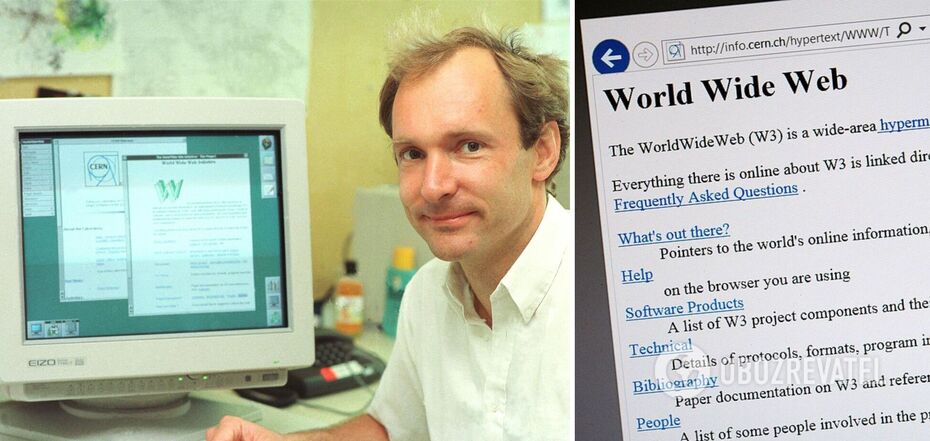Life
What the first Web site ever looked like: yes, it still works
Although many people already think that the World Wide Web has been with humanity, if not since the beginning of time, then for the last 100 years at least, in fact the first public Web site appeared only 32 years ago - on August 6, 1991. It may be strange, but its emergence was not without the "help" of the USSR.
As of 2023, there are more than 2 billion Web sites in the world, where everyone can find whatever they want: scientific data, pictures of the universe, stupid and even obscene jokes, porn ... But the World Wide Web has not always been a place for entertainment.
OBOZREVATEL tells about the first site in the history of the network and who created it.
Hypertext+TCP+DNS=WWWW
The very appearance of the network's progenitor was a kind of U.S. response to the launch of the world's first satellite, which the USSR managed to send into Earth orbit in 1957. In response, the U.S. decided to create the Advanced Research Projects Agency, which later created the Office of Information Processing Technology. It was this Office that developed the regulatory and technical framework that later led to a computer network to be used in the event of war.
For more than a decade this network existed only within Pentagon programs and was used for operational communications between the military. In the 1980s, however, Tim Berners-Lee entered the "scene," who, while working at CERN (the European Organization for Nuclear Research in Genève), developed a network for rapid communication between scientists.
Berners-Lee would later take another step toward revolutionizing it. In 1989 he created the World Wide Web, the World Wide Web to connect computer users around the world.
"I just had to take the idea of hypertext and combine it with the ideas of TCP and DNS and - ta-da! - the World Wide Web." Berners-Lee recounted.
Although he is considered the creator of the World Wide Web, Berners-Lee has a slightly different opinion, arguing that his role was only to bring together existing technologies into one.
"Creating the network was an act of desperation, because without it the situation was very difficult when I worked at CERN. Most of the technologies associated with the network, such as hypertext, the Internet, multiscript text objects, were already developed. All I had to do was put them together. It was a step of generalization, going to the highest level of abstraction, thinking about all the existing documentation systems as part of a larger imaginary documentation system," Berners-Lee explained.
By October 1990, he had written three technologies that remain the foundation of the modern network:
- HTML: Hypertext Markup Language. Markup language (formatting) for the web;
- URI: Uniform Resource Identifier. A kind of "address" that is unique and used to identify each resource on the network. Also often referred to as a URL;
- HTTP: Hypertext Transfer Protocol, which allows you to retrieve related resources from the entire network.
By Christmas 1990 he was able to implement the first ever successful communication between an HTTP client and a server. He then designed and built the first web browser, and as early as August 6, 1991 he launched the first web page in the history of the web.
It should be noted that although Berners-Lee invented the World Wide Web, he did not invent the Internet. And here's why:
The Internet is a network of computer networks (sounds like a tautology, but it is) that spans the world. It is the hardware and software that allows computers to combine with each other.
The World Wide Web is just a service of the Internet. It is a list of linked documents and resources and their specific location (via hyperlinks and URLs) on the Internet.
The first ever website
The first Web page appeared on August 6, 1991. Berners-Lee took great care in creating it, explaining how the World Wide Web works, how to create Web sites yourself, and what hypertext is. The site ran on a NeXT computer that was at CERN.
Even though 32 years have passed, the site address is still active, so you can open it and take a look back in time. The address of the first web page in the history of the web is: http://info.cern.ch/hypertext/WWW/TheProject.html.
Unfortunately, the original look of the site was not preserved, but its slightly modified page in 1992 looked (and looks now) like this:
Back to the Future
As of 2023, the World Wide Web has almost become where most of humanity lives. We can't imagine our lives without online news, video and music hosting, social media, and more.
While the question of how many websites there are may seem rhetorical, it can be answered with relative accuracy. According to webtribunal, there are about 2 billion Web sites, but most of them are just dead pages. The number of active websites, on the other hand, is about 400 million.
Every 5 minutes or so, there are also 1,500 new sites on the Web.
The World Wide Web is used by 51% of the world's population. Most of them are in Asia, which accounts for half of the world's network traffic.
Websites are developed in more than 200 languages, but only a few dominate the overall statistics - English, Chinese, Russian, German and Japanese.
Earlier OBOZREVATEL also told about who made the first ever photo of DNA.
Subscribe to the channels of OBOZREVATEL in Telegram and Viber to keep up with the latest events.




























